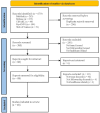Followership in interprofessional healthcare teams: a state-of-the-art narrative review
- PMID: 37696538
- PMCID: PMC12038140
- DOI: 10.1136/leader-2023-000773
Followership in interprofessional healthcare teams: a state-of-the-art narrative review
Abstract
Objective: A state-of-the-art (SotA) literature review-a type of narrative review- was conducted to answer: What historical developments led to current conceptualisations of followership in interprofessional healthcare teams (IHTs)?
Design: Working from a constructivist orientation, SotA literature reviews generate a chronological overview of how knowledge evolved and presents this summary in three parts: (1) this is where we are now, (2) this is how we got here and (3) this is where we should go next. Using the SotA six-stage methodology, a total of 48 articles focused on followership in IHTs were used in this study.
Results: Articles about followership within IHTs first appeared in 1993. Until 2011, followership was framed as leader-centric; leaders used their position to influence followers to uphold their dictums. This perspective was challenged when scholars outside of healthcare emphasised the importance of team members for achieving goals, rejecting a myopic focus on physicians as leaders. Today, followership is an important focus of IHT research but two contradictory views are present: (1) followers are described as active team members in IHTs where shared leadership models prevail and (2) conceptually and practically, old ways of thinking about followership (ie, followers are passive team members) still occur. This incongruity has generated a variable set of qualities associated with good followership.
Conclusions: Leadership and followership are closely linked concepts. For leaders and followers in today's IHTs to flourish, the focus must be on followers being active members of the team instead of passive members. Since theories are increasingly encouraging distributed leadership, shared leadership and/or situational leadership, then we must understand the followership work that all team members need to harness. We need to be cognizant of team dynamics that work within different contexts and use leadership and followership conceptualisations that are congruent with those contexts.
Keywords: development; effectiveness; followership.
© Author(s) (or their employer(s)) 2024. Re-use permitted under CC BY-NC. No commercial re-use. See rights and permissions. Published by BMJ.
Conflict of interest statement
Competing interests: None declared.
Figures
Similar articles
-
Leadership and Followership Dynamics in Interprofessional Health Care Teams: Attending Physician Perspectives.Acad Med. 2024 Nov 1;99(11):1208-1214. doi: 10.1097/ACM.0000000000005819. Epub 2024 Jul 22. Acad Med. 2024. PMID: 39042415
-
Leadership and Followership in Military Interprofessional Health Care Teams.Mil Med. 2021 Oct 26;186(Suppl 3):7-15. doi: 10.1093/milmed/usab118. Mil Med. 2021. PMID: 34724052
-
Leadership in interprofessional healthcare teams: Empowering knotworking with followership.Med Teach. 2021 Jan;43(1):32-37. doi: 10.1080/0142159X.2020.1791318. Epub 2020 Jul 16. Med Teach. 2021. PMID: 32673138
-
Interprofessional Healthcare Teams in the Military: A Scoping Literature Review.Mil Med. 2018 Nov 1;183(11-12):e448-e454. doi: 10.1093/milmed/usy087. Mil Med. 2018. PMID: 29741728
-
Followership: A review of the literature in healthcare and beyond.J Crit Care. 2018 Aug;46:99-104. doi: 10.1016/j.jcrc.2018.05.001. Epub 2018 May 6. J Crit Care. 2018. PMID: 29779828 Review.
Cited by
-
Objective structured clinical examination to teach competency in planetary health care and management - a prospective observational study.BMC Med Educ. 2024 Mar 19;24(1):308. doi: 10.1186/s12909-024-05274-9. BMC Med Educ. 2024. PMID: 38504289 Free PMC article.
-
Nurse Leaders' Perceptions of Followership Development Needs: A Descriptive Qualitative Study.J Nurs Manag. 2025 Apr 7;2025:7920607. doi: 10.1155/jonm/7920607. eCollection 2025. J Nurs Manag. 2025. PMID: 40230450 Free PMC article.
References
Publication types
MeSH terms
LinkOut - more resources
Full Text Sources




